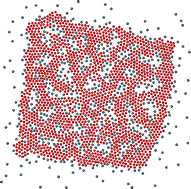Electrostatic interactions are essential in the function of biological entities. Most biomolecules are either strongly charged, like nucleic acids, or are composed of units with tunable degrees of charge, like proteins. As a result of these charges, the association of biomolecules into functional units is strongly dependent on local ionic concentrations. Herein, we discuss the control of the assembly and disassembly of simple biomimetic structures of macroions via ionic gradients generated by compositional heterogeneities in molecular electrolytes. We describe the importance of breaking the symmetry of the distribution of ionic components at interfaces in the function of co-assemblies of charged molecules. Composition heterogeneities in thermoreversible gels of charged chains linked by oppositely charged macroions are analyzed. The breaking of symmetry of the charge accumulation at the interfaces of the locally segregated domains of different ionic densities and the connectivity of the self-assembled network is related to the function of these hydrogels, such as their ability to store charge.

You have access to this article
 Please wait while we load your content...
Something went wrong. Try again?
Please wait while we load your content...
Something went wrong. Try again?


 Please wait while we load your content...
Please wait while we load your content...